Showing Spotlights 193 - 200 of 338 in category All (newest first):
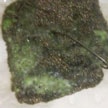 Given the huge economic incentives, corrosion prevention and protection is a major business. The advanced materials that are being developed and used in modern industries require increasingly sophisticated coatings for improved performance and durability. Take for example the case of microbially induced corrosion (MIC) - one of the lesser understood forms of corrosion where micro-organisms manifest metallic surfaces and induce substantial damage that often goes unnoticed until there is a loss in the component functionality. New research features graphene as a promising novel surface coating that can be used to minimize metallic corrosion under harsh microbial conditions.
Given the huge economic incentives, corrosion prevention and protection is a major business. The advanced materials that are being developed and used in modern industries require increasingly sophisticated coatings for improved performance and durability. Take for example the case of microbially induced corrosion (MIC) - one of the lesser understood forms of corrosion where micro-organisms manifest metallic surfaces and induce substantial damage that often goes unnoticed until there is a loss in the component functionality. New research features graphene as a promising novel surface coating that can be used to minimize metallic corrosion under harsh microbial conditions.
Oct 13th, 2015
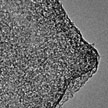 A carbon material with high electrical conductivity, high specific surface area, tunable pore structure, mechanically robust framework, and high chemical stability is an important requirement for advanced electrochemical energy storage. However, neither porous carbon or sp2 carbon can full meet these requirements yet. How to create a conductive carbon material with especially large pore volume, and hence large surface area, has therefore been a key focus in electrode research.
A carbon material with high electrical conductivity, high specific surface area, tunable pore structure, mechanically robust framework, and high chemical stability is an important requirement for advanced electrochemical energy storage. However, neither porous carbon or sp2 carbon can full meet these requirements yet. How to create a conductive carbon material with especially large pore volume, and hence large surface area, has therefore been a key focus in electrode research.
Oct 5th, 2015
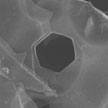 Synthesis of holey two-dimensional (2D) nanosheets with defined hole morphology and hole edge structures remains a great challenge for graphene. It is also an issue for other 2D nanomaterials, such as hexagonal boron nitride (h-BN) and molybdenum disulfide. In new work, researchers have reported a facile, controllable, and scalable method to carve geometrically defined pit/hole shapes and edges on h-BN basal plane surfaces via oxidative etching in air using silver nanoparticles as catalysts.
Synthesis of holey two-dimensional (2D) nanosheets with defined hole morphology and hole edge structures remains a great challenge for graphene. It is also an issue for other 2D nanomaterials, such as hexagonal boron nitride (h-BN) and molybdenum disulfide. In new work, researchers have reported a facile, controllable, and scalable method to carve geometrically defined pit/hole shapes and edges on h-BN basal plane surfaces via oxidative etching in air using silver nanoparticles as catalysts.
Oct 1st, 2015
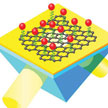 With increasing sensitivity, electrical, mechanical and optical sensors are able to detect low molecular weight chemical and biological analytes under ever more dilute conditions. At the same time, though, researchers want to keep the sensing process as simple as possible without complex functionalization and complicated preparation steps for the in situ detection. A novel graphene-gold metasurface-based biosensing architectures makes extreme phase singularities possible due to a strong field enhancement on the graphene-gold interface.
With increasing sensitivity, electrical, mechanical and optical sensors are able to detect low molecular weight chemical and biological analytes under ever more dilute conditions. At the same time, though, researchers want to keep the sensing process as simple as possible without complex functionalization and complicated preparation steps for the in situ detection. A novel graphene-gold metasurface-based biosensing architectures makes extreme phase singularities possible due to a strong field enhancement on the graphene-gold interface.
Sep 14th, 2015
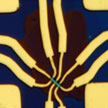 The noise level in devices with graphene and other two-dimensional (2D) materials has to be reduced in order to enable their practical applications. It will not be possible to build graphene-based communication systems or detectors until the noise spectral density is decreased to the level comparable with the conventional state-of-the-art transistors.Researchers have now demonstrated that the electronic noise in graphene devices can be strongly suppressed if a graphene channel is encased between two layers of hexagonal boron nitride.
The noise level in devices with graphene and other two-dimensional (2D) materials has to be reduced in order to enable their practical applications. It will not be possible to build graphene-based communication systems or detectors until the noise spectral density is decreased to the level comparable with the conventional state-of-the-art transistors.Researchers have now demonstrated that the electronic noise in graphene devices can be strongly suppressed if a graphene channel is encased between two layers of hexagonal boron nitride.
Jul 27th, 2015
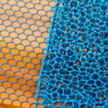 Since the first 'Scotch tape' method - i.e. mechanical peeling - of making graphene was reported in 2004, researchers have come up with a variety of techniques for producing graphene. Since simply using the as-produced graphene flakes is not good enough for use in sophisticated applications, intricate patterning processes are essential for the development of the required graphene structures for use in nanoelectronic and optical devices. Usinf a novel method, researchers have now successfully grown graphene from neat polystyrene regions.
Since the first 'Scotch tape' method - i.e. mechanical peeling - of making graphene was reported in 2004, researchers have come up with a variety of techniques for producing graphene. Since simply using the as-produced graphene flakes is not good enough for use in sophisticated applications, intricate patterning processes are essential for the development of the required graphene structures for use in nanoelectronic and optical devices. Usinf a novel method, researchers have now successfully grown graphene from neat polystyrene regions.
Jul 21st, 2015
 Researchers have demonstrated a novel, low-cost substrate processing procedure to achieve rapid, efficient synthesis of millimeter-sized single crystal graphene. One of the greatest challenges in commercializing graphene is how to produce high quality material, on an industrial scale, at low cost, and in a reproducible manner. The quality of graphene plays a crucial role as the presence of defects, impurities, domain boundaries, multiple domains, structural disorders, or wrinkles in the graphene sheet can have undesired or unexpected effects on its electronic and optical properties.
Researchers have demonstrated a novel, low-cost substrate processing procedure to achieve rapid, efficient synthesis of millimeter-sized single crystal graphene. One of the greatest challenges in commercializing graphene is how to produce high quality material, on an industrial scale, at low cost, and in a reproducible manner. The quality of graphene plays a crucial role as the presence of defects, impurities, domain boundaries, multiple domains, structural disorders, or wrinkles in the graphene sheet can have undesired or unexpected effects on its electronic and optical properties.
Jul 15th, 2015
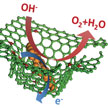 Researchers have been looking to design catalyst materials that can significantly enhance the performance of oxygen evolution reaction (OER), a key eletrode reaction that is an enabling process for many energy storage options such as direct-solar and electricity-driven water splitting and rechargeable metal-air batteries. However, OER suffers from sluggish kinetics - but a novel material inspired by the pomegranate might change that.
Researchers have been looking to design catalyst materials that can significantly enhance the performance of oxygen evolution reaction (OER), a key eletrode reaction that is an enabling process for many energy storage options such as direct-solar and electricity-driven water splitting and rechargeable metal-air batteries. However, OER suffers from sluggish kinetics - but a novel material inspired by the pomegranate might change that.
Jul 2nd, 2015
 Given the huge economic incentives, corrosion prevention and protection is a major business. The advanced materials that are being developed and used in modern industries require increasingly sophisticated coatings for improved performance and durability. Take for example the case of microbially induced corrosion (MIC) - one of the lesser understood forms of corrosion where micro-organisms manifest metallic surfaces and induce substantial damage that often goes unnoticed until there is a loss in the component functionality. New research features graphene as a promising novel surface coating that can be used to minimize metallic corrosion under harsh microbial conditions.
Given the huge economic incentives, corrosion prevention and protection is a major business. The advanced materials that are being developed and used in modern industries require increasingly sophisticated coatings for improved performance and durability. Take for example the case of microbially induced corrosion (MIC) - one of the lesser understood forms of corrosion where micro-organisms manifest metallic surfaces and induce substantial damage that often goes unnoticed until there is a loss in the component functionality. New research features graphene as a promising novel surface coating that can be used to minimize metallic corrosion under harsh microbial conditions.
 Subscribe to our Nanotechnology Spotlight feed
Subscribe to our Nanotechnology Spotlight feed





